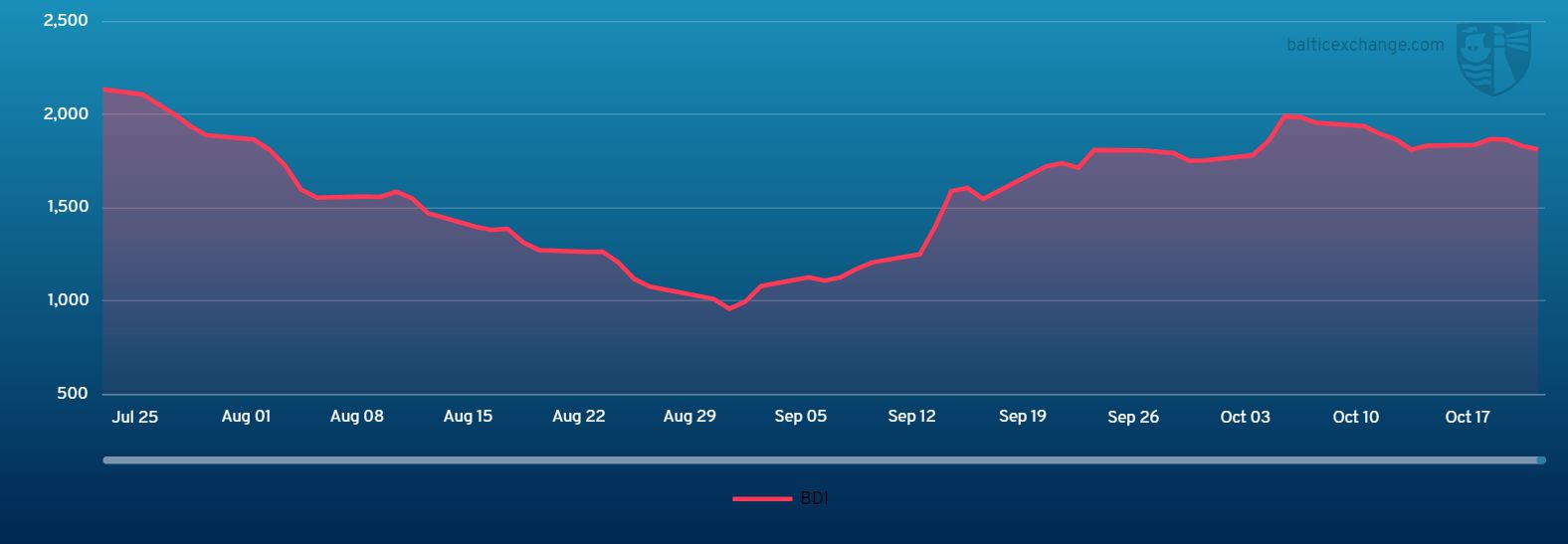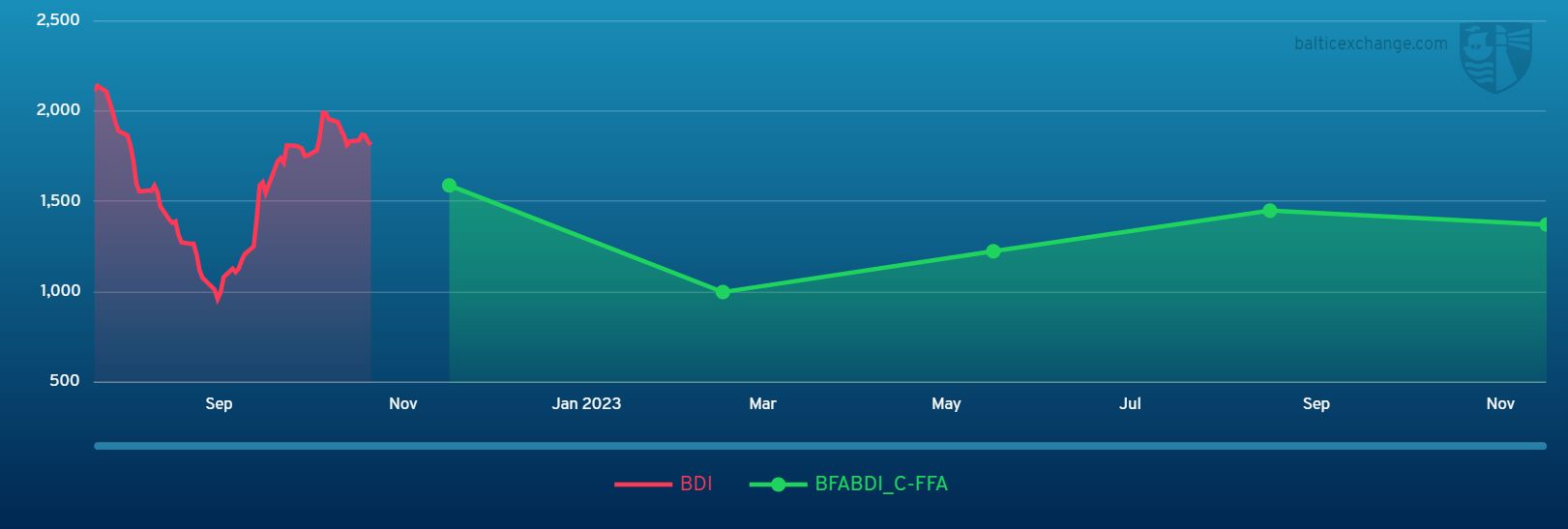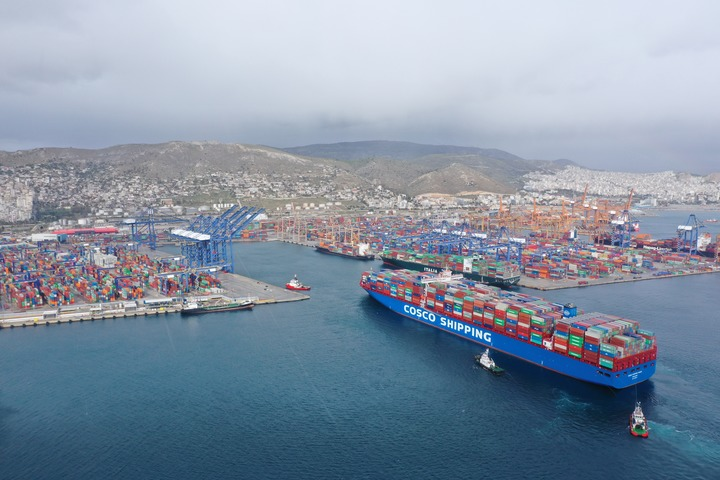BEIJING, Oct. 25 (Xinhua) -- The Baltic Exchange has published its weekly report of the dry and tanker markets for October 17-21, 2022 as below:
Capesize
Week-on-week the average of the weighted 5TC average declined $790, finishing the week at $17,175. The Brazil to Qingdao trade slipped two dollars throughout the week, whilst the West Australia to Qingdao trade remained static in the low/mid $9s. From the North Atlantic, both the transatlantic and fronthaul runs lifted midweek but showed signs of softening by the end, pricing at $24,194 and $36,875 per day respectively. But overall the sector had a relatively stable week amid ups and downs with tightness being seeing in some regions.
Panamax
The Panamax market returned a mixed week. Rates in the Atlantic were largely seen under pressure throughout the trading week. Solid demand from NoPac kept rates in Asia well supported throughout, although the market did taper off as the weekend approached. A distinct lack of mineral demand from the North were largely the contributing factors to the easing in rates in the North Atlantic. $19,000 concluded early in the week but was viewed closer to $18,000 by the weekend. US Gulf grains appeared to be back in focus again with numerous accounts of November arrivals being concluded, delays at Neo-Panama Canal were again impacting rates. Asia again proved to be dominated by solid levels of activity from the NoPac with $23,000 the high being agreed for a nicely described 82,000dwt delivery Japan on a NoPac round trip. Limited period activity but a smart design delivery China achieved $19,000 basis 5/7 months.
Ultramax/Supramax
A split week for the sector as Asia lacked impetus with limited fresh enquiry and a build up of prompt tonnage. However, overall, the sentiment remained positive in the Atlantic. Period activity was limited but a 61,000dwt open Poland was fixed for one year in the mid $17,000s and a 63,000dwt giving delivery Singapore fixed a similar period at $17,000. From the US Gulf, activity remained with ultramax sizes seeing close to $30,000 for trips to China. Further south, steady activity from east Coast South America with 58,000dwt fixing in the low to mid $17,000s plus around $725,000 ballast bonus for trips to the Indian Ocean – Arabian Gulf regions. Limited coal movement from Indonesia saw sentiment waning over the week. A 53,000dwt fixing delivery passing Singapore trip via Indonesia redelivery Vietnam in the mid $14,000s. Further north, a 58,000dwt open CJK fixed a trip to the US Gulf at around $13,000.
Handysize
With continued negativity in Asia, rates took a large step down this week. A 40,000dwt was rumoured to have been fixed for a trip from Japan to Southeast Asia at $13,500 and a 37,000dwt open in China was fixed for a trip via Indonesia back to China at $12,000. A 31,000dwt was fixed from Singapore via Australia to Southeast Asia at $11,000 with an intended cargo of salt. There has been more activity in the US Gulf, and a 39,000dwt was rumoured to have been fixed for a trip from Houston to Tunisia with an intended cargo of grains in the low $17,000s. A 36,000dwt was rumoured to have been fixed for a trip from Savannah to the UK-Continent with an intended cargo of wood pellets in the mid-teens but further details had yet to emerge. A 28,000dwt was fixed from Santos to Algeria with an intended cargo of sugar at $26,000.
Clean
The BCTI finished the week at 1,231, up from 1,226 the previous week.
In the Middle East Gulf freight levels stabilized with cargos evenly balanced with tonnage. Most routes consequently registered marginal increases from where they were the same time last week. The LR2s of TC1, 75k Middle East Gulf / Japan, went up from WS 196.25 to WS 197.81 (+1.56), a round-trip TCE of $36,162/day. LR1s have also seen a similar flat trajectory over the last week with TC5, 55k Middle East Gulf / Japan, climbing 6.43 points to WS 199.29. On TC8 Middle East Gulf / UK Cont, again the rates were barely budging from last week’s numbers finishing at 52.05 $/mt (a lumpsum equivalent of approximately $3.38m).
The MRs of TC17, 35kt Middle East Gulf / East Africa, were also subdued with charterers keeping cargoes back resulting in drop of 29.76 points to WS 338.57 a round trip TCE of $31,219 / day.
West of Suez, on the LR2s, TC15, 80k Mediterranean / Japan, have also softened losing $45,833 and finishing the week at $3,716,667.
The LR1s of TC16 60k Amsterdam / Offshore Lomé softened slightly by WS 2.14 ending up at WS 228.57.
On the UK-Continent, MRs freight levels registered gains with TC2 37k UK-Continent / US Atlantic Coast breaking through the WS 300 mark to finish at WS 301.94, (+WS 23.05). TC19 37k Amsterdam to Lagos, followed suit and finished at WS 311.07 (+WS 20.3).
Rates for U.S. Gulf MRs have calmed from their previous volatility and now appear subdued. TC14 38k US Gulf / UK-Continent, increased to WS 197.50 (+3.33) and TC18 the MR US Gulf / Brazil run also increased to WS 308.33 (+13.33). MR Atlantic Basket finished the week at 38,683 (+3,200).
VLCC
The VLCCs saw an upward trend across the board with large gains made especially when looking east. 270,000mt NHC Middle east Gulf to China rose over 13.5 points to finish at WS 107.5 (a TCE Round trip earning of $72,199) while West Africa-China 260,000mt NHC rose by over WS 15, to close at WS 107.45 (a round trip TCE Earning of 71,595). USG/China 270,000mt NHC saw similar rises gaining over $1M throughout the course of the week to finish at $11,700,000 a TCE round trip of $56,830.
A slightly more muted market going west still saw increases with Middle East/USG rising to finish the week at WS 57.33 (an increase of over $8,500 per day TCE earning to $21,595 per day round trip).
Suezmax
The Suezmax market from the Black Sea saw slight gains rising to WS 192.56 with a TCE daily return of $82,190. This was outperformed by the Middle East market, which had a further increase of over WS 12 points closing at WS 97.94 (a daily TCE Earning round trip of $26,078) for AG/Med 140,000mt NHC liftings.
Aframax
The Aframax market in the US has seen high volatility with huge gains especially made in the Caribbean-USG 70,000mt route, which ended at WS 380.63 - an increase of WS 156.25 over the course of the week. This was followed, if slightly less impressively, by gains of WS 65 for USG-ARA 70,000mt which still finished on WS 300 - a high for the year so far - and gave a TCE daily return of $65,762 per day round trip.
Over in Europe the market was steadier with increases for all routes but modestly so in comparison to the US. North Sea – Continent 80,000mt gained WS 5 points over the week to WS 211.56, while Baltic-UKC 100,000mt saw almost WS 10 points to finish at WS 233.75 (a TCE round trip daily earning of $77,390).
Headquartered in London and a subsidiary of the Singapore Exchange (SGX), the Baltic Exchange publishes a range of indices and assessments which provide an accurate and independent benchmark of the cost of transporting commodities and goods by sea. These include the Baltic Dry Index (BDI), the dry bulk shipping industry's best known indicator. Published daily since 1985, this provides a snapshot of the daily spot market earnings of capesize, panamax and supramax vessel types on the world's key trading routes.

Chart shows Baltic Dry Index (BDI) during July 22, 2022 to Oct.21, 2022

Baltic Forward Assessment for BDI
In March 2018 the BDI was re-weighted and is published using the following ratios of time charter assessments: 40 percent capesize, 30 percent panamax and 30 percent supramax. The information is provided by a panel of international shipbrokers.
(Source: The Baltic Exchange, edited by Niu Huizhe with Xinhua Silk Road, niuhuizhe@xinhua.org)




 A single purchase
A single purchase









